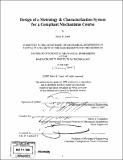Design of a metrology & characterization system for a compliant mechanisms course
Author(s)
Laird, Holly B
DownloadFull printable version (2.136Mb)
Alternative title
Design of a metrology and characterization system for a compliant mechanisms course
Other Contributors
Massachusetts Institute of Technology. Dept. of Mechanical Engineering.
Advisor
Martin L. Culpepper.
Terms of use
Metadata
Show full item recordAbstract
The purpose of this thesis was to learn about creating an educational kit as a tool for teaching professional engineers in industry about the theory of Freedom and Constraint Topology (FACT), and the new types of flexures that can be designed using this process. The importance of this thesis lies in the benefits compliant mechanisms give to precision engineering. The impact, by improving the quality of designs capable by professional engineers by teaching them about using FACT to design flexures, will contribute to higher quality, more agile, and more reliable technology worldwide. The metrological systems designed for the kit were comprised of a system of sensors and data collection apparati to analyze the physical characteristics of a particular type of flexure known as a "screw flexure", a compliant mechanism that has a single degree of freedom with coupled translational and rotational motion. Using lead weights of V4 to 2 pounds and two Mitutoyo #ID-S1012E digital Dial Indicators, measurements were taken for the translational and rotational deflection of the screw flexure. The pitch of the screw flexure was found to be 10.512 in/rad, which was a 9.4% error from the expected value of 11.5 in/rad. The experimental setup was a successful tool for teaching FACT methodology in the specific case of the screw flexure.
Description
Thesis (S.B.)--Massachusetts Institute of Technology, Dept. of Mechanical Engineering, February 2008. Includes bibliographical references (leaf 34).
Date issued
2008Department
Massachusetts Institute of Technology. Department of Mechanical EngineeringPublisher
Massachusetts Institute of Technology
Keywords
Mechanical Engineering.